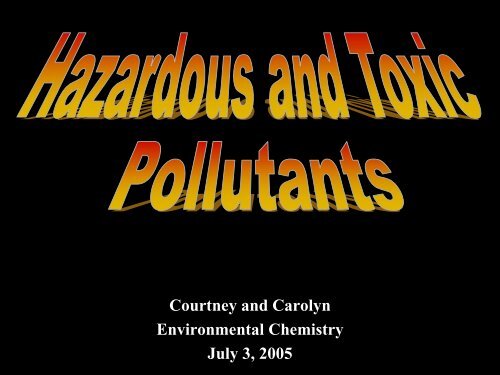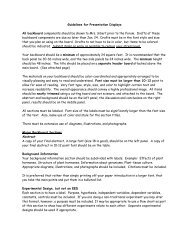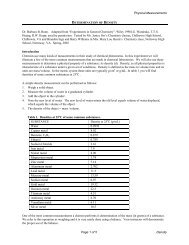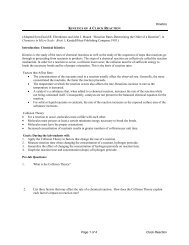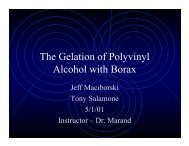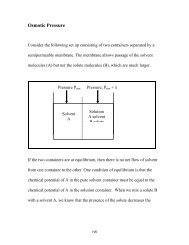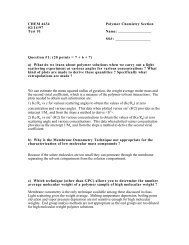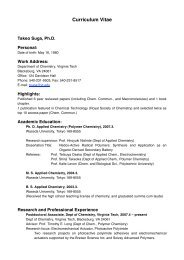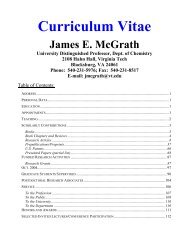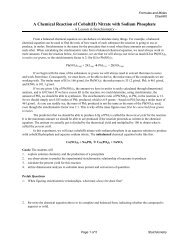Create successful ePaper yourself
Turn your PDF publications into a flip-book with our unique Google optimized e-Paper software.
Courtney and CarolynEnvironmental ChemistryJuly 3, 2005
OverviewI. The Definition of “<strong>Toxic</strong>Pollutant”II. Nonmetal <strong>Pollutants</strong>A. AsbestosB. BenzeneC. DDTD. DioxinsE. ChlorofluorocarbonsIII. Metal <strong>Pollutants</strong>A. LeadB. MercuryC. ArsenicD. CadmiumE. ChromiumIV. Efforts MadeV. ReferencesVI. Biographies
What is a “toxic pollutant?”• Includes chemical compounds and heavy metals thatcan harm organisms or adversely alter their way of life• Possible sources: industries, household products,farming practices, runoff• Bioaccumulation:Binds tosoil andwaterparticlesConsumedby worms,midges, andsmall fishThe wormsand smallfish are eatenby biggerorganisms<strong>Pollutants</strong>accumulate inhigher levels ofthe food chain,causing healtheffects
Nonmetal: Asbestos•Properties:–long, thin fibers that occurnaturally and can besuspended in the air–Will not burn or corrode– strong and can insulate•Uses:http://www.co.fairfax.va.us/service/hd/atphotos.htmmainly used in insulation,building supplies (such astiles), fire-proof materials,paper materials, asbestos-cement materials, andasbestos-reinforced plasticshttp://www.atsdr.cdc.gov/asbestos/asbestos_whatis.html
Nonmetal: Asbestos• Source of Exposure:–Damaged asbestos materialsrelease fibers into the air–water contamination is due toerosion of natural minerals anddeterioration of asbestos-cement pipes and roofing–Most exposure is in industries,affecting mainly maintenanceand custodial workers–EPA and other federal agencieshave set restrictions on the useof asbestos and amount ofexposure•Health Effects:–Can lead to a lung diseasecalled asbestosis (scarring ofthe lungs)–Can lead to lung cancer–May lead to mesothelioma(cancer of abdominalcavity’s s lining)–connection betweencontaminated water andcancer of intestines,stomach, and esophagushttp://www.asbestos-mesothelioma.com/asbestos-fibers.html
Nonmetal: Benzene• Properties:–colorless, volatile, andflammable liquid–highly soluble in water–Chemical formula is C 6 H 6• Uses:–motor fuels–manufacture of explosives,detergents, and dyestuffs–solvent for oils, waxes,resins, fats, inks, plastics,paints, and rubberhttp://www.highbeam.com/library/doc0.asp?docid=1P1:30521275&dtype=1~1~0~0&dinst=0~&author=&title=benzene&date=01/01/1999&refid=ency_toppm
Nonmetal: Benzene• Sources of Exposure:–emitted into air due toincineration of coal andoil, exhaust fromvehicles, and evaporationfrom gasoline stations–Half of national exposureto benzene is due totobacco smoke• Health Effects:–dizziness, drowsiness,headaches–irritation of eyes,respiratory tract, and skin–creates blood disorders–increase in leukemiaincidences in humans whoare around benzeneoccupationally–classified as a humancarcinogen
Nonmetal: DDT• Properties:– white, tasteless, odorless,crystalline solid– does not occur naturally• Uses:–First introduced to fightagainst disease frominsects during WWII–was later sold outside themilitary as a pesticide toreduce the amount ofinsects on crops and tocontinue fighting insect-born diseases–now banned in the U.S.
Nonmetal: DDT•Sources of Exposure:–Some countries, such as Mexico, still use DDT.–DDT sticks to the soil for 100’s s of years and can betransported over long distances–Can still be detected in North American wildlife•Health Effects:– large use of DDT can kill wildlife and can be found in higherlevels of the food chain due to bioaccumulation–can harm the nervous system–may affect the liver and reproductive system–classified as a probable human carcinogen
Nonmetal: Dioxins• Properties:– group of compounds with similar structures and characteristics,including three close families: the chlorinated dibenzo-p-dioxinsdioxins(CDDs), chlorinated dibenzofurans (CDFs), and certainpolychlorinated biphenyls (PCBs)– Mainly refers to 2,3,7,8-tetrachlorodinitrotetrachlorodinitro-p-dioxin dioxin (TCDD)– Contaminant of wood preservatives, chlorinated herbicides, andAgent Orange (defoliant used in the Vietnam War)• Sources of Exposure:– formed from combustion of particular plasticsor wood–#1 source is from burning household trash– breaks down very slowly– accumulates in food chain and is stored inanimal fathttp://www.dioxinfacts.org/sources_trends/trash_burning.html
Nonmetal: Dioxins• Health Effects:– almost every living being has some dioxins in body since pollutant isso widespread– if exposed to large amounts, , leads to chloracne (skin disease)– may also lead to skin discoloration, skin rashes, and some liverdamagehttp://cybersarges.tripod.com/Chloracne.html
Nonmetal:Chlorofluorocarbon• Properties:– Mainly contain chlorine,fluorine, and carbon– Non-flammable,directly non-toxic, no odor, low boilingpoints• Uses/Sources of Exposure:– Was used as refrigerants,aerosol-spray spray can propellants,foam agents, and solvents formicroelectronic parts– In 1980’s s and 1990’s, CFCsescaped to atmospheres• Environmental Effects:– In the stratosphere, CFCsundergo a chemicalreaction and release achlorine atom, which candestroy ozone.– Decompose slowly,lasting up to 100 years– In the 1980s, an“Antarctic ozone hole”was discoveredCF 2 Cl 2CF 2 Cl + Cl
Nonmetal:Chlorofluorocarbonhttp://www.cmdl.noaa.gov/ozone.htmls • Health Effects:– Due to decrease in amount ofozone, shorter wavelengths oflight (ultraviolet radiation)can reach the earth– UV radiation includes UV-Aand UV-B, which causessunburns– Increase in skin-cancerincidences– 2 main types of skin cancer:squamous cell carcinoma andmalignant melanoma
Metal: Lead• Properties:– A heavy metal commonlyfound in sulfide ores.– Found naturally in the air,soil, water and plants.– In it’s s pure form it is abluish-white shiny metal.Uses:- Plumbing material- Previously used as a pigmentbase in paint.- Gasoline additive- Lead-acid acid batteries, a typicalcar batteryhomepages.ihug.co.nz/ ~pincha/glassmins.htmlmicro.magnet.fsu.edu/.../ batteries/leadacid.html
Metal: Lead• Sources of Exposure:– Drinking water can become contaminated when lead pipes and storage tanksbecome corroded, in the presence of soft water.– Lead paint chips are often consumed by small children. Paint chips are oftenfound in older houses.– Fumes from lead ore smelters are generally localized, but still have an impacton the environment.– Lead gasoline has been effectively phased out in the USA, however r othercountries still use lead gasoline, which emits lead into the environment.– The decomposition of lead-acid acid batteries in local waste sites can also lead tothe contamination of local streams.• Health Effects:-The ingestion of lead by children can cause slowed growth and nervoussystem disorders such as hyperactivity.-In adults high levels of lead can cause reproductive problems, nervous nsystemdisorders, joint pain, memory and concentration problems and digestiveproblems.
Metal: Mercury• Properties:-Silvery, toxic heavy metal that is aliquid at room temperature-Can also be found and digested inthe form of alkylmercury andmethylmercury•Uses/Sources of Exposure:http://pasture.ecn.purdue.edu/~mercury/src/release.htm-Mercury is naturally methylated (effectively made more toxic) in mostshellfish-Higher levels of mercury can be ingested by eating fish that have e been livingin a high mercury environment. Bioaccumulation can then occur, increasingthe amount of mercury that a human would consume.-Minamata,, Japan and the plant manufacturing acetaldehyde.-Mercury vapor can be ingested at the work place, either in the mining mindustry or in chloralkali plants.-Fluorescent light tubes and mercury arc lamps often contain mercury. Ifdisposed of incorrectly, the mercury can leak into the environmentnt.
Metal: Mercury• Health Effects:– Constant exposure to elemental mercury cancause damage to the central nervous system.This damage includes tremors, psychologicalchanges, insomnia, loss of appetite, irritability,headache and short-term term memory loss.– Inhalation of high levels of mercury vapor cancause the onset of symptoms such as cough,dyspnea, , chest pain, nausea, vomiting, diarrhea,fever and a metallic taste in the mouth.– Mercury accumulates in the body, often in thekidneys, bone marrow, liver, spleen, lungs, skinand hair. It takes a long time for mercury to exitthe body, and process of mercury poisoning isoften slow.– Mad as a hatter was derived from the fact thatfelt often contained mercury(II) nitrate whichwas inhaled when the hat was constructed.http://www.villagehatshop.com/product46.htmlhttp://www.ericharshbarger.org/lego/mad_hatter.html
Metal: Arsenic• Properties:– Naturally occurringmetal found in the Earthscrust.– Grey in its pure form.– Occurs in both inorganicand organic compounds.•Uses/Sources of Exposure:•Inorganic arsenic compounds are used to preserve wood, whose particlescan be inhaled or touched.•Organic arsenic compounds have been used as pesticides.•Arsenic can be found in may household products such as rat poison n andherbicides, however the amount of arsenic products is decreasing.•Most of the arsenic found n ground water is the result of mineralsdissolving from weathered rock and soils. Some areas are more prone ptoarsenic in drinking water than others.http://www.waterindustry.org/policies.htm
Metal: Arsenic• Health Effects:– Arsenic is a mutagen, and can cause cancerwhen there is prolonged exposure. Arsenicincreases the risk of lung cancer, skin cancer,bladder cancer, liver cancer, kidney cancer,and prostate cancer in particular.– Lower levels of arsenic can cause nausea andvomiting, decreased production of red andwhite blood cells, abnormal heart rhythm,damage to blood vessels, and a sensation of"pins and needles" in hands and feet.– Ingesting low levels of inorganic arsenic fora long period of time can cause the skin todarken and small ‘corns’ or ‘warts’ to appearon the palms, soles and torso.www.enn.com/news/ennstories/2001/09/09142001/s_44958.asp
Metal: Cadmium• Properties:– Rare but toxic metal.– Generally occurs in nature asthe mineral greenockite.– Normally mined with zinc•Uses/Sources of Exposure:•Can be found in pigments and plastic stabilizers.www.orbik.co.uk/nickel1.htm•Nickel-cadmium cadmium rechargeable batteries are a large source of the substance.•The batteries have military and industrial applications that include lighting,portable hospital equipment and satellites. The popularity of these tbatteries isgrowing in the home area as well, with the use of them in toys, cameras andphones.•The amount of cadmium in municipal solid waste is growing due to thedisposal of nickel-cadmium cadmium batteries.•However, the most damage is done by direct exposure to cadmium that canbe found in the workplace and in factories.
Metal: Cadmium• Health Effects:– Breathing high levels of cadmiumcan severely damage the lungs andcan lead to death.– Ingesting high levels of mercurycan severely irritate the stomach,leading to vomiting and diarrhea.– Long term exposure to cadmium tolower levels of cadmium can leadto build up of cadmium in thekidneys and possibly kidneydisease.– Fragile bones and lung damage isalso an effect of long termexposure to cadmium.www.nmh.org/services/transplant/kidney_disease.htmlhttp://www.homehealth-uk.com/medical/asthma.htm
Metal: Chromium• Properties:– Naturally occurring element found in rocks andsoils.– The most common forms are chromium(0),chromium(III), and chromium(VI).– Chromium(III) occurs naturally in the environmentand is an essential nutrient for the human body.– The other forms of mercury are generally producedby the industrial process.•Uses/Sources of Exposure:•The metal form of chromium {chromium(0)} is used to make steel.•Chromium(VI) and chromium(III) are used for chrome plating,dyes and pigments, leather tanning, and wood preserving.•Contaminated water and chromium in the workplaces are theprimary ares pf exposure to the metal forms of chromium.jchemed.chem.wisc.edu/.../MAINPT/CmCz_elt/Cr.HTM•Foods containing chromium(III) can also be ingested, but this formof chromium casues no harm.
Metal: Chromium• Health Effects:– The body uses chromium(III) as an essential nutrient to help the body usefat, sugar and protein.– Breathing high levels of chromium(IV) can casue nose blleds and seriousdamage such as ulcers and holes in the nasal septum.– Ingesting high levels of chromium(IV) can cause stomach upsets and aulcers,convulsions, kidney and liver damage, and even death.– Chromium(IV) can increase the risk of lung cancer and has been shown stobe a human carcinogen.http://www.proteinfactory.co.uk/productlist.asp?productTypeID=16http://www.cmmart.com/healthinfo/10foods.htm
Efforts MadeThe EPA has made many efforts toward reducing theamount of exposure to pollutants. It...• is the largest federal agency• uses one-seventh of the national budget• outputs more regulations than any other federalagencyCompanies and businesses are also making an effort toreduce their output of pollutants.
ReferencesMitchell, Mark K. and William B. Stapp. Field Manual for Water QualityMonitoring. Dexter, MI: Thomson-Shore, Inc., 1994.Theodore, Mary K. and Louis Theodore. Major Environmental Issues Facing the21 st Century. . Upper Saddle River, NJ: Prentice Hall, 1996.Bunce, Nigel. Environmental Chemistry. . Winnipeg: Wuerz Publishing Ltd, 1994.. 14 July 2004.. 14 July 2004.. 14 July 2004.. 14 July 2004.. 14 July 2004.. 14 July 2004.. 20 July 2004.. 20 July2004.. 20 July 2004.. 20 July 2004.. 20 July 2004.. 20 July 2004.
BiographiesCourtneyI live in South Boston,Virginia, and I am a rising seniorat Halifax County High School.My favorite subjects are chemistryand biology. In my free time, Ienjoy playing the piano and violin,playing tennis, and reading. Ihope to pursue my interest inscience and become a researcher.CarolynI live in Manassas, Virginia and I willbe a senior at Osbourn Park HighSchool in the fall of 2004. I enjoyplaying field hockey and soccer. Ienjoy reading and riding around inmy car. My favorite subjects arebiology and chemistry. I plan onpursuing my dream to become adoctor.


